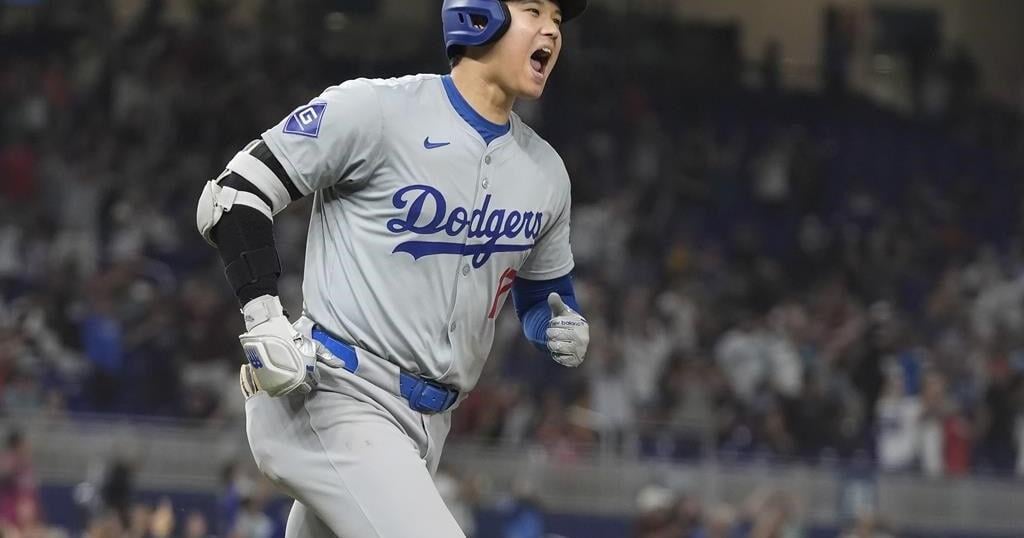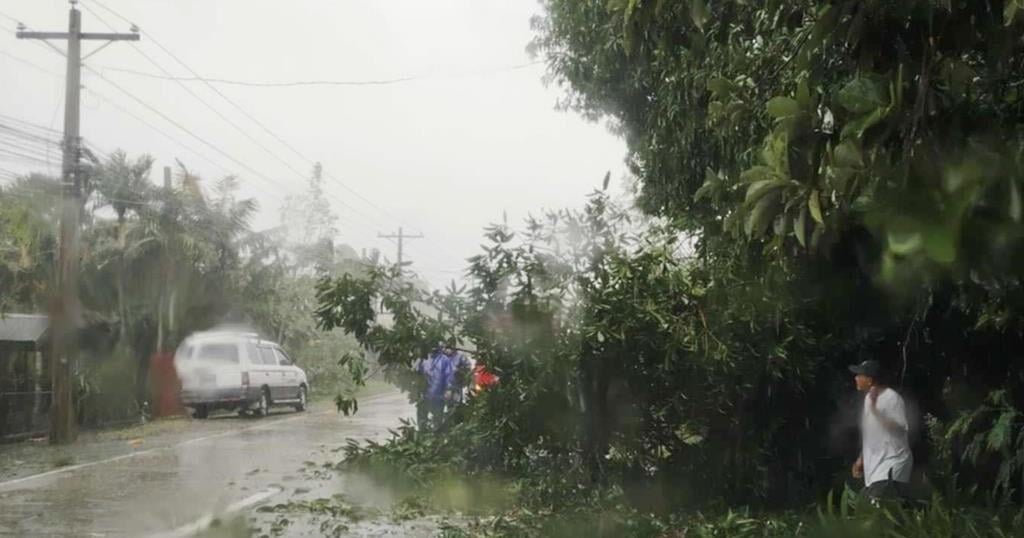MIAMI (AP) — Shohei Ohtani looked up at a visiting crowd that turned out to cheer him and the Los Angeles Dodgers — and ended up getting to witness one of the greatest individual performances, and seasons, in major league history.
Fans lifted their phones to capture the moment and chanted “M-V-P!” as Ohtani rounded the bases after he cleared the fence for the 50th time, becoming the first major league player with at least 50 home runs and and 50 stolen bases in a season.
“I almost cried, to be honest,” shortstop Miguel Rojas said. “It was a lot of emotions because of everything that happens behind the scenes that we got to witness every single day.”
The most amazing thing about it? Ohtani’s day wasn’t even finished.
Ohtani raced past the 50-50 milestone in the most spectacular game of his history-making career, becoming the first big league player to hit three homers and steal two bases in a game during a 20-4 rout of the Miami Marlins on Thursday that also secured a playoff spot for the Dodgers.
Los Angeles’ $700 million Japanese superstar hit his 49th homer in the sixth inning, his 50th in the seventh and his 51st in the ninth. He finished 6 for 6 with 10 RBIs while becoming the first big league player to hit three homers and steal two bases in a game.
“It was something I wanted to get over as quickly as possible. And, you know, it’s something that I’m going to cherish for a very long time,” Ohtani said through an interpreter in a televised interview.
Ohtani reached the second deck in right-center on two of his three homers at LoanDepot Park. In the sixth inning, he launched a 1-1 slider from George Soriano 438 feet for his 49th.
Ohtani hit his 50th homer in the seventh, an opposite-field, two-run shot to left against Marlins reliever Mike Baumann. Then, in the ninth, his 51st traveled 440 feet to right-center, a three-run shot against Marlins second baseman Vidal Brujan, who came in to pitch with the game out of hand.
“To be honest, I’m the one probably most surprised,” Ohtani said. “I have no idea where this came from, but I’m glad that it was going well today.”
Ohtani came into the game with 48 homers and 49 steals. He took care of the stolen bases early, swiping his 50th in the first and his 51st in the second. He has been successful on his last 28 stolen base attempts.
He broke the Dodgers’ franchise record of 49 homers set by Shawn Green in 2001. And he became the third player in major league history with at least six hits, three homers and 10 RBIs in a game, joining Cincinnati’s Walker Cooper in 1949 and Washington’s Anthony Rendon in 2017.
Ohtani has 120 RBIs, trailing only Aaron Judge of the New York Yankees (53 homers, 136 RBIs) in both categories.
Ohtani reached the 50-50 milestone in his 150th game. He was already the sixth player in major league history and the fastest ever to reach 40 home runs and 40 stolen bases in a season, needing just 126 games.
His previous career high in homers was 46 for the Los Angeles Angels in 2021, when he also made 23 starts on the mound and won his first of two American League MVP awards.
It was another memorable night for Ohtani at LoanDepot Park, where he struck out then-Angels teammate Mike Trout of the United States for the final out of the 2023 World Baseball Classic championship while playing for Japan.
“I’ve had perhaps the most memorable moments here in my career,” Ohtani said, “and this stadium has become one of my favorite stadiums.”
Already the consensus best player in baseball whose accomplishments as a pitcher and batter outpaced even Babe Ruth, Ohtani reached new heights as an offensive player while taking the year off from pitching.
Ohtani signed a $700 million, 10-year deal with the Dodgers last December. The two-way star, who previously spent six years with the Los Angeles Angels, has played exclusively at designated hitter this season as he rehabilitates after surgery a year ago for an injured elbow ligament.
He finished a triple shy of the cycle on Thursday, adding a run-scoring single and two doubles. He was thrown out at third base while trying to stretch his second double into a triple.
“There’s nothing you really can say because there’s nothing anybody can do about it,” teammate and former MVP Mookie Betts said. “He’s just too good.”
First base was open when Ohtani came up to bat in the seventh, but Marlins manager Skip Schumaker decided against intentionally walking him with the Marlins trailing 11-3.
“If it was a tight game, one-run lead or we’re down one, I probably put him on,” Schumaker said. “Down that many runs, that’s a bad move baseball-wise, karma-wise, baseball god-wise. … I think out of respect for the game, we were going to go after him. He hit the home run. That’s just part of the deal. He’s hit (51) of them. He’s the most talented player I’ve ever seen.”
Preparation was a key to Ohtani becoming the first member of the 50-50 club. He regularly huddled with the team’s hitting coaches and studied video of opposing pitchers to understand their tendencies with hitters and baserunners.
“I see all the work he puts in,” catcher Will Smith said recently. “It’s not like he goes out there and it’s too easy for him. He works harder than anybody. He scouts really hard. He’s playing a different game so it’s fun to see.”
Ohtani appeared to make the 50-50 mark his mission. He increased the frequency of his base-stealing attempts, and in turn his success rate went up.
But that may not be the case next year when he returns to the mound.
“He’s not pitching this year so I think he is emptying the tank offensively,” manager Dave Roberts said. “I do think the power, the on-base (percentage), the average, I think he can do that as a pitcher. He’s done something pretty similar like that with his OPS. But as far as the stolen bases go, I’m not sure about that.”
Ohtani’s teammates have enjoyed watching him crush home runs and scamper around the bases.
“I’m honestly kind of trying to learn from him just seeing the way he goes about his day-to-day business. He’s very consistent, the same demeanor throughout,” outfielder Tommy Edman said recently. “I think that’s why he’s such a good player.”
Third baseman Max Muncy added, “Every night I feel like he does something that we haven’t seen.”
What’s next for Ohtani?
The Dodgers are headed to the postseason in October, which will be another first for Ohtani. He never made it there with the Angels, who never had a winning record during his tenure in Anaheim.
Another potential first could be earning National League MVP honors as a designated hitter. No player who got most of his playing time as a DH — without pitching — has ever won MVP, although Don Baylor, Edgar Martinez and David Ortiz placed high in the vote.
It would be Ohtani’s third career MVP award.
___
AP Sports Writer Beth Harris in Los Angeles contributed to this report.
___






















